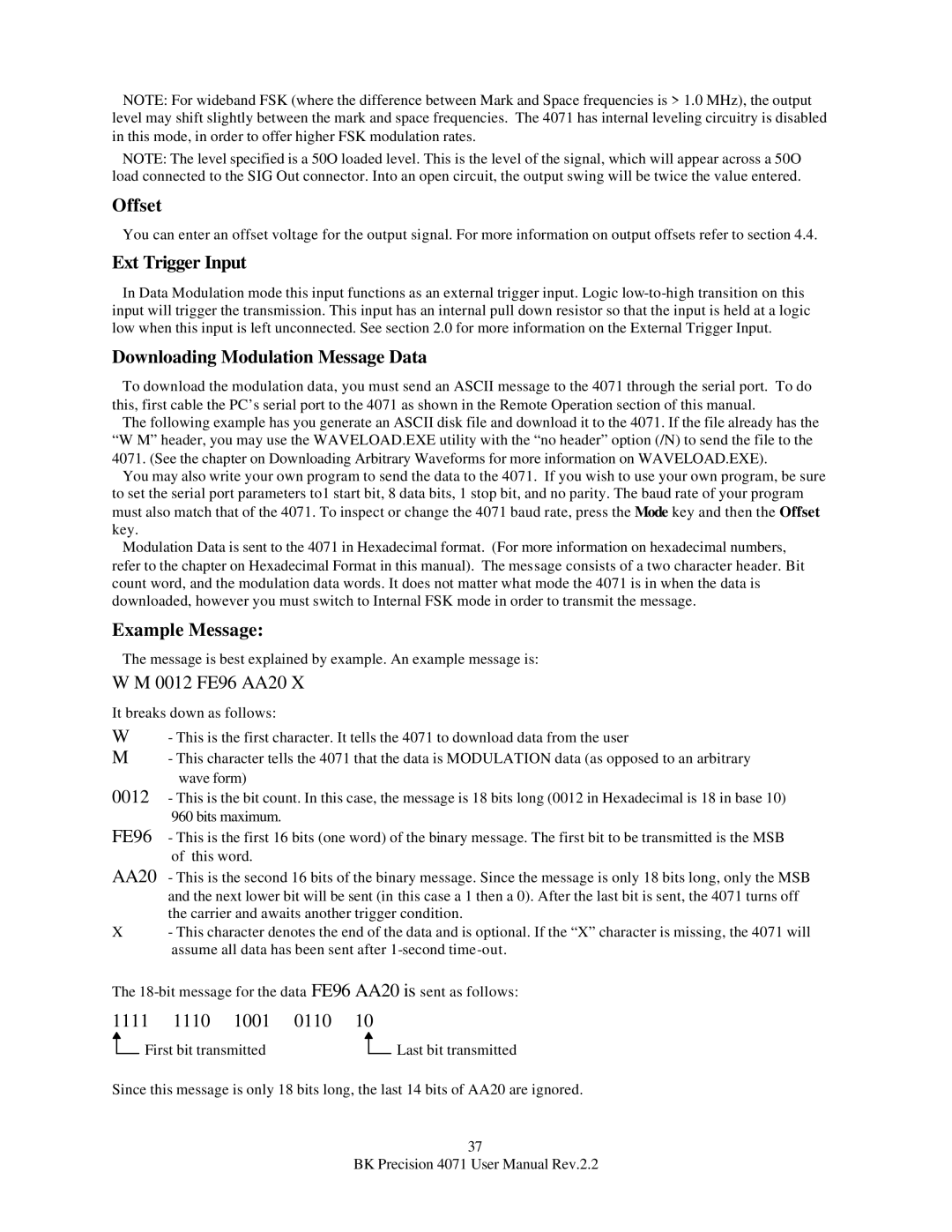NOTE: For wideband FSK (where the difference between Mark and Space frequencies is > 1.0 MHz), the output level may shift slightly between the mark and space frequencies. The 4071 has internal leveling circuitry is disabled in this mode, in order to offer higher FSK modulation rates.
NOTE: The level specified is a 50O loaded level. This is the level of the signal, which will appear across a 50O load connected to the SIG Out connector. Into an open circuit, the output swing will be twice the value entered.
Offset
You can enter an offset voltage for the output signal. For more information on output offsets refer to section 4.4.
Ext Trigger Input
In Data Modulation mode this input functions as an external trigger input. Logic
Downloading Modulation Message Data
To download the modulation data, you must send an ASCII message to the 4071 through the serial port. To do this, first cable the PC’s serial port to the 4071 as shown in the Remote Operation section of this manual.
The following example has you generate an ASCII disk file and download it to the 4071. If the file already has the “W M” header, you may use the WAVELOAD.EXE utility with the “no header” option (/N) to send the file to the 4071. (See the chapter on Downloading Arbitrary Waveforms for more information on WAVELOAD.EXE).
You may also write your own program to send the data to the 4071. If you wish to use your own program, be sure to set the serial port parameters to1 start bit, 8 data bits, 1 stop bit, and no parity. The baud rate of your program must also match that of the 4071. To inspect or change the 4071 baud rate, press the Mode key and then the Offset key.
Modulation Data is sent to the 4071 in Hexadecimal format. (For more information on hexadecimal numbers, refer to the chapter on Hexadecimal Format in this manual). The message consists of a two character header. Bit count word, and the modulation data words. It does not matter what mode the 4071 is in when the data is downloaded, however you must switch to Internal FSK mode in order to transmit the message.
Example Message:
The message is best explained by example. An example message is:
W M 0012 FE96 AA20 X
It breaks down as follows:
W- This is the first character. It tells the 4071 to download data from the user
M- This character tells the 4071 that the data is MODULATION data (as opposed to an arbitrary wave form)
0012 - This is the bit count. In this case, the message is 18 bits long (0012 in Hexadecimal is 18 in base 10) 960 bits maximum.
FE96 - This is the first 16 bits (one word) of the binary message. The first bit to be transmitted is the MSB of this word.
AA20 - This is the second 16 bits of the binary message. Since the message is only 18 bits long, only the MSB and the next lower bit will be sent (in this case a 1 then a 0). After the last bit is sent, the 4071 turns off the carrier and awaits another trigger condition.
X- This character denotes the end of the data and is optional. If the “X” character is missing, the 4071 will assume all data has been sent after
The
1111 | 1110 | 1001 | 0110 | 10 |
![]() First bit transmitted
First bit transmitted
![]() Last bit transmitted
Last bit transmitted
Since this message is only 18 bits long, the last 14 bits of AA20 are ignored.
37
BK Precision 4071 User Manual Rev.2.2
